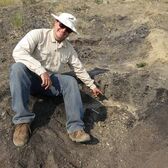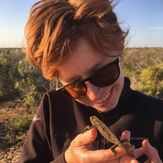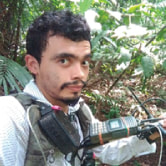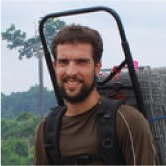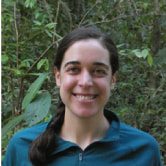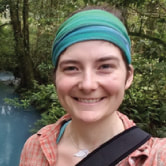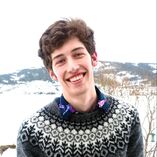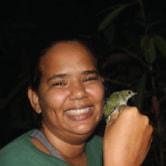Marina AnciãesInstituto Nacional de Pesquisas da Amazônia (INPA)
[email protected] https://labecainpa.wixsite.com/labeca |
Marina is a biologist engaged to the study of animal behavior and evolution, focusing on Neotropical birds from the family Pipridae (the Manakins). Leading the Animal Behavior and Evolutionary Biology Lab (LABECA) at the National Institute for Amazonian Research (INPA) in the center of Amazon, Brazil, she advises and teaches graduate students on sampling and analyzing behavioral data to conduct field-based empirical research (but some experimental work too) on animal communication (mostly visual and some acoustics). Together with her current and past students she is conducting interdisciplinary research integrating behavioral ecology, visual and acoustic ecologies, evolution of communication systems, macroecology and biogeography. She applies a variety of methodological tools to investigate lekking behavior, occupation of visual and acoustic niches, ecological niches and their evolution. Marina is particularly interested in the role of sexual selection in the diversification of phenotypes in animals, and is willing to share data continuously through the Manakin Genomics RCN and to engage in collaborative studies to improve research quality and outreach.
Chris Balakrishnan
|
Dr. Chris Balakrishnan first observed a manakin as an undergraduate in 1996 and has wanted to work on manakins ever since. Twenty years after this experience, he is excited to finally work on manakins via this RCN! Work in his lab is aimed at understanding how genes and the environment interact to generate biodiversity. By combining an evolutionary perspective with functional and comparative genomics, they seek to uncover both the genomic basis of evolutionary adaptation and the ecological and demographic processes responsible for population divergence. Chris’ goal in the RCN is to help introduce ecologically and behaviorally-focused researchers to the world of genomics and to introduce "genomicsy" folks to the world of manakins.
Maude Baldwin
Max Planck Institute for Ornithology, Evolution of Sensory Systems Research Group
[email protected] http://www.orn.mpg.de/3645505/Research_Group_Baldwin |
Maude studies the evolution of taste receptors and digestive enzymes in birds, with a focus on fruit- and nectar-feeding species. She is very interested in what taste good to manakins and what makes them choose the fruits and insects that they eat, and how their sensory systems differ from those of their close relatives.
Kevin Bennett
Smithsonian National Museum of Natural History and University of Maryland, College Park
[email protected] http://www.braunlab.umd.edu/ |
Kevin is a PhD student advised by Dr. Mike Braun studying a hybrid zone between Golden-collared and White-collared Manakins in Panama. He is working to uncover the genetic basis of sexual traits and better understand the dynamics of introgression across the hybrid zone.
Jacob BervUniversity of Michigan
[email protected] https://scholar.google.com/citations?user=cQQaGZQAAAAJ&hl=en |
Jake Berv recently completed his Ph.D. at Cornell University (August 2019), where he studied avian systematics and phylogenomics. Jake’s interests intersect macro- and microevolutionary scales and questions, and range from sexual selection in cotingas and manakins to macroevolutionary patterns across modern birds (as well as other groups). One of Jake’s Ph.D. chapters considered whether transient body size reduction in the wake of the Cretaceous-Paleogene mass extinction may have induced deterministic changes in the population genetics of surviving lineages. This work synthesized data and methods from paleontology, comparative biology, and molecular systematics, and developed conceptual links between population level processes and macroevolutionary patterns. In addition, Jake also spent much of his Ph.D. developing Pseudopipra as a system for studying diversification across Amazonian and Andean areas of endemism. Jake’s interest in Amazonian avifanua began with a multi-facted study of Cotinga phylogeny, which was guided by Dr. Richard Prum after Jake completed his undergraduate studies at Yale University. Recently, Jake’s (and co-authors') first major work on Pseudopipra was made available as a pre-print on bioRxiv (https://www.biorxiv.org/content/10.1101/713081v1). Jake will start a new position as a Life Sciences Fellow at the University of Michigan in November 2019, and is excited to get involved with the Manakin RCN as it moves forward. His major interests as they pertain to the RCN include contributing to studies of manakin phylogeny, phylogeography, and diversification, as well as applying modern comparative phylogenetic methods and developing genomic resources.
Peri BoltonEast Carolina University, Greenville NC and Smithsonian National Museum of Natural History
[email protected] peribolton.weebly.com |
Peri is an evolutionary biologist from Australia, and is very excited to study such amazing birds. Peri did her PhD and Endeavour Postdoctoral Fellowship on the evolutionary and conservation genetics of the colourful Australian Gouldian finch. Peri will be working with Chris Balakrishnan, using gene expression data to explore the proximate mechanisms of cooperation and sociality in the wire-tailed manakin.
Mariane Bosholn
National Institute for Research in the Amazon (INPA), Manaus - AM - Brazil
[email protected] http://labecainpa.wixsite.com/labeca |
Mariane is a PhD.candidate in the Ecology graduate program at the National Institute of Amazonian Research (INPA) in Manaus, Brazil. For her PhD., she is studying the effects of glucocorticoid hormones (especially corticosterone) on the health, lekking behavior and coloration of blue crowned manakin (Lepidothrix coronata) in Central Amazon, Brazil.
Alice Boyle
|
Alice is an Assistant Professor and studies birds living in both wet tropical forests and mid-continental grasslands. She got into manakins by studying altitudinal migration of White-ruffed Manakins (Corapipo altera) on the Caribbean slope of Costa Rica. Results of that work led to current research aiming to understand the role of climate (and particularly, rain) in shaping tropical bird life history. She is currently working on the interplay between sexual selection and environmental constraints with Corapipo in Parque Nacional Volcán Tenorio in Costa Rica.
Edward L. Braun
University of Florida, Department of Biology
[email protected] https://people.clas.ufl.edu/ebraun/ and https://orcid.org/0000-0003-1643-5212 |
Edward's research focus is the intersection of biodiversity and genomics. Much of my work has been in the areas of molecular evolution, phylogenetics, and computational biology. I am interested in models of genomic change and the use of those models to make functional inferences at a variety of scales (ranging from molecules to whole organisms and populations). I use a variety of approaches, ranging from theory and data mining to laboratory methods, to ask questions about the evolution of genes and genomes. I have worked on diverse organisms but most of my recent work has used birds and reptiles. I am also dedicated to fostering undergraduate research, integrating authentic research into the classroom, and improving STEM pedagogy.
Jeff Brawn
|
Jeff Brawn currently serves as Professor and Head of the Department of Natural Resources and Environmental Sciences at the University of Illinois, a position he has held for 8 years. Jeff received a B.S. in Wildlife Biology from the University of Massachusetts at Amherst in 1975, a M.S. in Wildlife from the University of Missouri in 1979, and a Ph.D. in Zoology-Ecology from Northern Arizona University in 1985. Jeff’s graduate research focused on the population biology of cavity nesting birds. Jeff studies basic and applied ecology with an emphasis on the biology of birds. Jeff has worked in the Republic of Panama for over 30 years where – in collaboration with the Smithsonian Tropical Research Institute, grad students and colleagues – he has studied the demography, life histories, and behavior of tropical forest birds. Recently, Jeff has explored relationships among expected climate change, especially altered precipitation regimes, land use practices, and the viability of tropical bird populations. Manakins are prominent in this research as tow species are common in the understory in the forests of central Panama.
César Cestari |
Cesar studies ecology and behavior of birds. He is focused in the biodiversity of the tropics, mainly in Brazil (South America) where he has been working for a long time. He investigates the proximal and evolutionary factors that may influence behavior of birds in a changing world dominated by anthropogenic and natural habitats. Considering the manakins clade (Pipridae), he investigated the diet, seed-dispersal activity, cost and benefits in display activity of males, and hierarchical interactions among males of white-bearded manakins (Manacus manacus) in southeastern Brazil. These themes were part of his thesis and pos doc. His general goal in behavioral ecology is to produce scientific material and help to approximate the academic and the non-academic communities in an easy way to conserve the biodiversity and consequently its direct benefit effects to humanity, such as ecosystem services.
Ioana Chiver
|
Ioana is interested in understanding how ecological conditions produce variation in behaviors and ultimately shape the evolution and diversity of traits. She is also interested in the role of hormones in “translating” ecological information to influence the development and expression of behaviors. Her studies have focused on the link between ecological conditions and mating behaviors of birds, particularly singing behavior. More recently, she has been studying the highly complex and acrobatic display of Golden-collared Manakins, specifically the extent that the neural circuitry is developed in females and can be activated by testosterone during adulthood. Ioana is interested in expanding the work to examine the development of courtship behavior. Field work takes place in Panama, near the town of Gamboa and on the island of Escudo.
Camilo Andres Alfonso Cuta
Department of Biological Sciences Virginia Tech
[email protected] https://www.globalchange.vt.edu/camilo-alfonso/ |
Camilo conducted his undergraduate studies at the Dr. Gary Stiles’ lab in the Universidad Nacional de Colombia where he acquired his passion and interest for the bird world. For his undergraduate thesis, he studied the natural history of the Saffron-crested Tyrant-manakin (Neopelma chrysocephalum) as part of a Ph.D. project studying bird populations in white sand forest fragments of the Peruvian Amazon. His results showed that N. chrysocephalum is primarily an insectivorous manakin that can feed on some fruit species. In addition, he found that this species is able to recognize neighbors from strangers at leks using playback experiments. He hopes this basic information can contribute to the purpose of the ManakinGenomics RCN objectives. Over the last three years, he has been working for Dr. Brandt Ryder and collaborators in the wire-tailed manakin project in Ecuador, and Dr. Corey Tarwater in a multi-species study (including manakins!) in Panama. Currently, he has a Fulbright scholarship to conduct his Ph.D. starting in 2018, and would like to keep studying the behavior, physiology, and ecology of manakins, and keep collaborating to the manakin genomics group.
Roslyn Dakin
|
Roslyn is a postdoctoral fellow working with Brandt Ryder at the Smithsonian to study the social behavior of wire-tailed manakins. This work leverages Dr. Ryder’s proximity logging system to track the movements of an entire population of wire-tailed manakins during their cooperative courtship displays in Ecuador, to understand the factors that promote cooperation. Before joining SCBI, she studied animal movement on a smaller scale, using video to track the acrobatic maneuvers of hummingbirds (postdoc) and the courtship displays of peacocks (PhD). Ever since seeing long-tailed manakins in Costa Rica, she has been interested in how morphology, muscle capacity, and vision influence behavior.
Lainy DayDepartment of Biology, Neuroscience Minor, University of Mississippi
[email protected] https://biology.olemiss.edu/people/faculty/lainy-day/ |
Lainy seeks to understand the evolution of brain and behavior evolve. She has been studying how complex behaviors drive neural and physiological adaptations in bird families that have extraordinary mating displays since 1999. She has been enjoying the antics of manakins since 2006 after years of following bowerbirds. Lainy focuses both on species specific adaptations variation across species within the manakin family in order to determine patterns of trait evolution. She strives to connect as many levels as possible from genes to behaviors.
Robert Driver
|
Robert is a graduate student in Dr. Chris Balakrishnan's lab at East Carolina University. He is hoping to contribute to the Manakin Genomics RCN by annotating and curating genomes to identify proper coding regions and splicing sites. He would also like to contribute to comparative studies that are now possible with our new manakin phylogeny. Robert and other RCN members are also analyzing transcriptome data from different manakin genera to understand the genetic mechanisms behind fast dancing displays.
Emily H. DuVal
|
Emily has been fascinated by the behavior and social dynamics of manakins since the first year of her PhD. Lance-tailed manakins form alliances of alpha and beta males that work together to perform two-male courtship displays. Emily works with a team of researchers at Florida State University to investigate cooperation, mate choice, physiological mechanisms, and their evolutionary implications in this species. This work is based in a long-term study population of lance-tailed manakins in Western Panama, which has been monitored intensively since 1999.
Carolina Ferreira
National Institute of Amazonian Research, Genetics, Conservation and Evolutionary Biology graduate program
[email protected] http://evoamazon.net |
Carolina is a Masters student in the Genetics, Conservation and Evolutionary Biology graduate program at the National Institute of Amazonian Research. For her Masters, she is studying plumage color evolution using the blue-crowned manakin (Lepidothrix coronata) as a model. The blue-crowned manakin is widely distributed, showing a great degree of color variation that does not seems to be limited by rivers. The main goal of her research is to understand the evolution of color by quantifying environmental and phylogenetic contributions. She aims to understand if different phenotypes are associated with different niches; or if different phenotypes are result of sexual selection, and how phylogenetically labile evolution of color is.
Paul FrandsenBrigham Young University, Plant & Wildlife Sciences
[email protected] http://lifesciences.byu.edu/~paulbryf |
Paul generally studies insects, but when given the shot to help with work on manakins, he jumped at the opportunity. Paul is interested in comparative genomics and phylogenetics. He uses these tools in an attempt to uncover evolutionary patterns and to make sense of the biological variation we observe in the world. While his main focus is the aquatic insect order Trichoptera, Paul is engaged on work on genomes from taxa spread throughout the tree of life.
Sami Friedrich |
Sami is a PhD candidate in the Department of Behavioral Neuroscience at Oregon Health and Science University in the lab of Dr. Claudio Mello. Her dissertation work focuses on how developmental gene regulation gives rise to marked sex dimorphisms in key avian brain structures that underly sexually dimorphic behaviors like birdsong. She has expertise in utilizing genome browsers and sequence databases for comparative genomics, and enjoys coding in python for data analysis and visualization. Her primary interests are the evolutionary and ontological bases of sex differences in the brain, as well as science outreach at public schools in her community.
Leonida Fusani
Konrad Lorenz Institute of Ethology, University of Veterinary Medicine, Vienna; Department of Cognitive Biology, University of Vienna
[email protected] https://www.vetmeduni.ac.at/en/konrad-lorenz-institute-of-ethology/ https://cogbio.univie.ac.at/people/staff/leonida-fusani |
Leonida Fusani was born in Florence, educated in Italy and the United Kingdom, and has worked in Germany, USA, and Italy. Since 2014 is Professor of Animal Physiology and Ornithology at the University of Veterinary Medicine, Vienna, and at the University of Vienna. His main research interests are elaborate courtship displays and animal migration, and for his studies has conducted fieldwork in several areas of the world including Equatorial Africa, Central America and the Himalayas, funded among others by the Max-Planck-Society, the National Geographic Society, the National Science Foundation, and the European Council. Since 2001 he works regularly as a Visiting Scientist at the Smithsonian Tropical Research Institute in Panama. For his innovative approach that bridges animal physiology and evolutionary biology, he received in 2007 the Frank A. Beach Award from the Society for Behavioural Neuroendocrinology.
Matthew Fuxjager
|
Matthew studies the evolution and physiology of social dance displays in animals, including manakins. Much of his work is aimed at unraveling how hormones act within the brain and muscular systems to mediate the production of incredible acrobatics that are linked together into sophisticated gestural signaling routines. His approach combines concepts and techniques from a wide range of fields, comparative phylogenetics, animal behavior, endocrinology, neuroscience, and genomics, which is what brings him to the Manakin RCN.
Milene Garbim Gaiotti
|
Milene is a PhD student studying sexual selection and the social and genetic mating system of Antilophia bokermanni.
André de Camargo Guaraldo |
André has a Ph.D. in Ecology from Universidade de Brasília and a Masters degree in Botany from UNESP. He is a specialist in bird ecology, with an emphasis in continental migratory species. He has studied in multiple areas within ornithology, such as natural history, comparative ecology, breeding biology, stable isotope ecology, bioacoustics and citizen-science. He collaborates with Dr. Lilian Manica's team in multiple studies and with whom he developed a fascination for the complex displays of the Swallow-tailed Manakins (Chiroxiphia caudata) and a big curiosity to deeply understand the ecological aspects connected to them, including gesture patterns, vocalization, bioacoustics, movement, and breeding success.
Brent M. HortonMillersville University, Millersville, PA
[email protected] http://www.millersville.edu/biology/faculty/b_horton.php |
As a physiological and behavioral ecologist, Brent integrates endocrinology and genetics with behavioral ecology to deconstruct the neuroendocrine and genomic architecture of vertebrate social behavior. His manakin-based research examines how hormones (e.g., testosterone) mediate the complex social behaviors of male wire-tailed manakins (Pipra filicauda). This research requires a collaborative effort, and he works with several members of the Manakin Genomics RCN team on this project, including Brandt Ryder, Ignacio Moore, Benjamin Vernasco, Matthew Fuxjager, and Christopher Balakrishnan. Together, they hope to better understand how individual differences in circulating testosterone and neuroendocrine gene expression underlie variation in male behavioral phenotype, social status and, ultimately, social network structure.
Erich JarvisThe Rockefeller University- Professor/ Howard Hughes Medical Institute- Investigator
[email protected] https://www.rockefeller.edu/our-scientists/heads-of-laboratories/1159-erich-d-jarvis |
Erich Jarvis, PhD is the head of the Laboratory of Neurogenetics of Language and professor at The Rockefeller University. He is also a scientific investigator with Howard Hughes Medical Institute (HHMI). Dr. Jarvis uses song-learning birds and other species as models to study the molecular and genetic mechanisms that underlie vocal learning, including how humans learn spoken language. He is interested in how their brains, and ours, have evolved to produce this complex behavior.
Judith JanischKonrad Lorenz Institute of Ethology, Department of Interdisciplinary Life Science, University of Veterinary Medicine of Vienna, Austria
[email protected] https://fusanilab.org/people/judith-janisch/ |
Judith is a PHD student at the University of Veterinary Medicine Vienna advised by Dr. Leonida Fusani. Her main interests involve the understanding of how sexual selection and female choice shaped very elaborate and extraordinary behavior. Therefore, she studies the courtship display of golden- collared manakins (Manacus vitellinus) in the tropical forests of Panama. For her investigations she uses new technological approaches including a 3D high-speed camera system adapted for field recordings and an automated tracking software using deep learning algorithms.
Blake Carlton Jones
|
Blake is a Postdoctoral Scholar at Florida State University. Most of Blake’s research has focused on how stress endocrinology mediates learning, memory, and perception in free-living birds. In 2017 Blake joined forces with Emily DuVal to investigate variation in life history trajectories and social behavior in lance-tailed manakins (Chiroxiphia lanceolata). Specifically, they are investigating the links among stress-physiology, telomeres, and cooperative courtship among young males. Additionally, they are interested how the El Niño Southern Oscillation influences reproductive output and the social dynamics among males.
Lia Nahomi Kajiki
|
Lia is an ornithologist and PhD student at the University of Brasília, with extensive fieldwork experience in different environments across Brazilian regions (Amazon, Atlantic forest, Cerrado and Caatinga regions). Her main research interests involve understanding how natural and anthropogenic processes drive species diversity, the evolution of sociality and social networks in birds, and sexual selection. She is currently much interested in uncovering unanswered questions regarding the evolution of genetic mating systems and sexual selection in Neotropical birds. In order to do so, she is studying the natural history and breeding biology of the Helmeted Manakin (Antilophia galeata), a species endemic to the Cerrado biodiversity hot spots.
Rebecca Kimball |
Rebecca is an evolutionary biologist, and her research incorporates molecular techniques and field research to examine evolutionary patterns and processes. There are several main foci in her research program: 1) microevolutionary processes like the evolution of mating systems and sexual selection; 2) population genetics; 3) phylogenetics and the use of phylogenies for comparative studies and to examine patterns of trait evolution (including male secondary sexual traits and display behaviors); and 4) linking changes in the genome with changes at the organismal level in an evolutionary framework to elucidate the proximate and ultimate causes of these changes. Rebecca is involved in manakin phylogenetics, trait evolution and genomics.
Sarah E. Kingston
|
Sarah is a molecular ecologist interested in gene flow across hybrid zones and the genomic architecture of adaptive traits. She is involved with efforts to use highly multilocus genotyping techniques to discern the genes underlying a sexually selected plumage trait, the yellow throat patch, which is introgressing across a hybrid zone from Manacus vitellinus to M. candei. Populations in the the hybrid zone along the Rio Changuinola in Bocas del Toro province, Panama are of particular interest.
Sarah Kurtis |
Sarah Kurtis is a PhD candidate in the Department of Biology at the University of Florida in Rebecca Kimball's lab. Sarah studies the genetic and ecological underpinnings of plumage coloration to understand what drives the maintenance or loss of phenotypic variation at the proximate and ultimate levels. She is currently finalizing a pipeline to isolate genomic markers from manakin raw sequencing data and published genomes using a read-mapping approach to later be used in a phylogenetic context.
Haw Chuan (HC) Lim
|
HC is an assistant professor at the Department of Biology, George Mason University. He uses genomic tools to study speciation and diversification in manakins, particularly the golden and white-collared manakins. His study also looks at genetic loci, underlying traits that are under sexual selection.
Rafael N. Leite
|
Rafael is an evolutionary biologist working on a species-level phylogeny of the manakin family (Pipridae) using target enrichment of ultraconserved elements and exons as part of a former post-doc fellowship on phylogenomics. He is interested in how different analytical approaches can help us understand the systematic relationships of manakins as a means to provide robust phylogenetic hypotheses for macroevolutionary and behavioral studies.
Bette Loiselle
Center for Latin American Studies, Department of Wildlife Ecology and Conservation, University of Florida
[email protected] http://www.loisellelab.org/ |
Bette holds a joint appointment as the Director of the Tropical Conservation in the Center for Latin American Studies and Professor in the Department of Wildlife Ecology and Conservation at the University of Florida. She has long been interested in manakins and her dissertation research on frugivory, seed dispersal, and ecology of birds in Costa Rica featured several species of manakins. Since 2001, her work on manakins has been based in western Amazonia where several species of manakins co-occur in one of the most species-rich locations on the planet. In this system, she is particularly interested in the evolutionary ecology of lek-mating systems in birds and how the spatial ecology of females influences mate choice decisions and male reproductive strategies. Other questions of interest in the lab are the importance of biodiversity to ecological function, especially seed dispersal and consequences for plant regeneration, the consequences of global change for distribution of plants and animals, and building collaborative learning networks to advance science and action.
Kira Long
|
Kira is a Ph.D. student at the University of Illinois Urbana-Champaign currently being co-advised by Dr. Jeff Brawn at the University of Illinois and by Dr. Mike Braun at the Smithsonian Museum of Natural History and University of Maryland. Her current dissertation research is on the hybridization dynamics and population genomics of the Manacus hybrid zone in Bocas del Toro, Panama. This hybrid zone is between the White-collared Manakin (Manacus candei) and the Golden-collared Manakin (Manacus vitellinus). In the field, Kira and her crew mistnet, monitor nests, and track females and fledglings with radio telemetry. In the lab, Kira makes Restriction Site DNA (RAD) libraries for genomic sampling and qPCR to assess parasite loads. She enjoys field work and has worked in North, Central, and South America as well as South Africa and is interested in combining genomic data with ecological studies. Her primary interests are in tropical ecology, sexual selection, and avian behavior.
Leilton Willians Luna |
Leilton is a PhD candidate from the Federal University of Pará and Emílio Goeldi Museum, Brazil. His main interest is to understand how species-specific traits interact with geographic and ecological barriers during the evolutionary diversification process. With the Manakins, Leilton study the patterns of genetic variability of the critically endangered Araripe Manakin (Antilophia bokermanni), and his sister species the Helmeted Manakin (Antilophia galeata), in aspects such as: i) population genetic structure across fragmented habitats; ii) selection of candidate genes linked to plumage color; iii) genetic diversity assessment for long term conservation monitoring. He also has expertise in philogeographic and demographic genomic analysis methods based on coalescent models.
Regina H. Macedo
Universidade de Brasilia, Brazil
[email protected] and [email protected] www.comportamento-animal.weebly.com |
Regina is a professor at Universidade de Brasilia, Brazil. Her interests are in behavioral ecology and conservation of Neotropical brids, with a focus on sexual selection, cooperative breeding and mating systems. She has long held an interest in manakins, and during the past six years has been able to conduct studies on two manakin species, Antilophia bokermanni and A. galeata. These ongoing studies have been developed as part of the doctoral theses of two of her students, Milene Gaiotti and Lia Nahomi, both of whom also participate in the ManakinGenomics project. These two manakin species are apparently the only ones that inhabit non-equatorial type habitats, with A. bokermanni occurring in dry forests of northeastern Brazil while A. galeatta occurs in the gallery forests in savanna habitats of central Brazil.
Lilian Manica
|
Lilian is a professor at Federal University of Paraná and coordinator of the Behavioral Ecology and Ornithology Lab of this university. The main aim of her lab is to unveil bird breeding behavior, with a special focus on courtship displays involving dances, vocalizations and colorful plumages. In the Atlantic Forest of South Brazil, Lilian and her students have been fascinated by the splendid display of the Swallow-tailed manakin (Chiroxiphia caudata), a species which social and sexual behavior is still poorly studied. Her research projects comprise from basic descriptions of behaviors to a deeper understanding of sexual selection mechanisms acting upon this species.
Claudio V. Mello |
Claudio’s research focuses on neural and genetic mechanisms of vocal learning. This trait enables young animals to learn vocalizations by imitating adults and provides an important basis for human speech and language learning. Claudio studies mostly zebra finches in the laboratory, but also performs comparative analyses with suboscines (including manakins), hummingbirds, parrots and other avian groups, using neuroanatomy, bioacoustics and functional and comparative genomics. He has also contributed to the generation and analyses of avian genome assemblies and brain gene expression databases. This includes an extensive zebra finch brain in situ hybridization database (ZEBrA) that has helped to identify numerous markers of vocal nuclei and generated new insights into the function and evolution of vocal circuits in birds. He is very interested in developing studies on the neurobiology of vocalizations and motor control in manakins.
Eliot Miller
|
Eliot is a postdoctoral researcher at the Cornell Lab of Ornithology. He uses fieldwork to fuel his ideas, collect preliminary data, and generate hypotheses, then he tests those hypotheses at the macroevolutionary scale with phylogenetic comparative approaches. Most of his field time has been in South America and in Australia, but his interests are global.
Andre Moncrieff
|
Andre Moncrieff is a PhD student in biological sciences at Louisiana State University. His research is focused on the phylogeography and population genomics of Blue-crowned Manakins (Lepidothrix coronata). The genetic variation within this widespread species is striking: many rivers such as the Amazon, Napo, Ucayali, and Japura, as well as the Andes Mountains define distinct genetic clusters. In addition to studying the influence of different dispersal barriers on genetic structure, Andre is interested in studying the genetic basis of the two color morphs of this species. Adult male Blue-crowned Manakins are either green-bodied (in southern Peru, southern Brazil, and Bolivia) or black-bodied (everywhere else). Additional research interests include describing the location and width of the hybrid zone between the color morphs, and studying the roles of selection vs. genetic drift in influencing plumage color variation.
Ignacio Moore
|
Ignacio is an organismal biologist who is primarily interested in animal behavior. He studies the wire-tailed manakin at the Tiputini Biodiversity Station in the Ecuadorian Amazon along with his colleagues Brent Horton and project leader, Brandt Ryder. They are interested in the neural, genomic, and endocrine correlates of behavior in these birds. The wire-tailed manakin is interesting because males display complex courtship behavior and social networks.
Monica (Moni) Munoz-TorresTranslational and Integrative Sciences Lab, Oregon State University
munoztmo [at] oregonstate [dot] edu https://tislab.org/ |
Dr. Munoz-Torres is a curator of genomes, and her work has focused on facilitating the development of software tools that accomplish these tasks, both structural and functional genome curation. She is a highly accomplished genomics scientist with extensive experience at the computer and at the bench. Moni is an experienced project manager for bioinformatics software development (e.g., for the Apollo, and the Gene Ontology consortium projects), and has been very successful in building and growing communities around genome curation efforts. That's why she joined the Manakin Genomics RCN! The idea to help shepherd a new era in research for this community was an exciting opportunity she didn't want to miss! Moni is the Program Manager for the Monarch Initiative, an integrative data and analytic platform connecting phenotypes to genotypes across species, bridging basic and applied research with semantics-based analysis.
Pedro PauloInstituto Nacional de Pesquisas da Amazônia – INPA, Manaus, Amazonas, Brazil
[email protected] http://labecainpa.wixsite.com/labeca |
Pedro is currently pursuing a master's degree in Ecology at the National Institute of Amazonian Research (INPA, Manaus, Brazil). His master’s thesis investigates geographic variation in the courtship behavior of blue-crowned manakins (Lepidothrix coronata), associating them to genetic variability (phylogeography) and environmental effects (ecological niche models). Blue-crowned manakins are widespread in the Amazon and exhibit one of the most striking cases of geographic plumage variation in adult males. The populations are comprised of totally black, totally green, as well as black-and-green male individuals. Their courtship behavior is considered one of the most complex for the number of elements, including stereotyped flights, maneuvers, and vocalization. Knowing the variation and behavioral complexity in this species can potentially reveal a level of variation not yet recognized in the group. Pedro’s goal at RCN is to aggregate behavioral information and associate it with genetics.
Andreas R Pfenning
|
Dr. Andreas is an Assistant Professor of Computational Biology at Carnegie Mellon University. The goal of the Pfenning laboratory is to build a set of computational and experimental genomic tools to study how genome sequence influences neural cells, neural circuits, disease, and behavior. The group is conducting research on the evolution of vocal learning, the genetics of Alzheimer’s disease, the epigenetics of aging, and the genetics of addiction. Andreas joined Carnegie Mellon University in 2016 after studying epigenetic mechanisms of Alzheimer’s disease as a postdoctoral associate in a joint position between the Computer Science and Artificial Intelligence Laboratory of the Massachusetts Institute of Technology and the Genetics Department of Harvard Medical School. He has a PhD in Computational Biology and Bioinformatics from Duke University in 2012, where he identified convergent evolution in gene expression patterns underlying bird’s song and human speech. He has a BS in Computer Science, from Carnegie Mellon (2006).
Marco Aurélio Pizo
|
Marco is an ecologist based at the State University of São Paulo (UNESP) in Rio Claro, Brazil. He is mostly interested in frugivory by birds, including manakins, iconic frugivorous birds of Neotropical forests. He has done most of his work in the Brazilian Atlantic forest. With Cesar Cestari, his former student, he has also investigated aspects of the lekking behavior of Manacus manacus.
Ghislaine Cárdenas Posada
Fuxjager lab, Wake Forest University
personal ([email protected]), institutional ([email protected]) https://www.fuxjagerlab.com/ghislaine-cardenasposada/ |
Ghislainea is a Colombian PhD student in Dr Fuxjager Lab at Wake Forest University. She is interested in neotropical ornithology, specially in how the environment, physiology and genes shape the behavior of Manakin species. She has worked previously with Chiroxiphia pareola in the Amazon in Ecuador, but currently is interested in working with the Manacus genre. She has also participated in the bioinformatics workshop organized by the ManakinGenomicsRCN.
Richard O. PrumWilliam Robertson Coe Professor of Ornithology at Yale University
[email protected] https://prumlab.yale.edu/ |
Richard O. Prum is the William Robertson Coe Professor of Ornithology at Yale University, and the Curator of Ornithology in the Yale Peabody Museum of Natural History. Prum is an evolutionary ornithologist with broad interests in avian biology. A life-long birdwatcher, Prum has done research on many topics including bird phylogeny, behavioral evolution, feather development and evolution, structural coloration, sexual selection, mimicry, and the dinosaur origin of birds. He has conducted fieldwork on bird on all continents, and has studied fossil theropods in China. In 2017, he published The Evolution of Beauty, which was named one of the Top Ten Books of the Year by the New York Times, and was a finalist for the 2018 Pulitzer Prize in General Non-Fiction. His popular writing has appeared in the New York Times, New Yorker, Scientific American, and Natural History Magazine. He has been awarded MacArthur, Guggenheim, and Fulbright Fellowships.
Pedro Henrique Lima Ribeiro
|
Pedro is a PhD student in Zoology in Federal University of Paraná and has been working with blue manakins (Chiroxiphia caudata) since his masters in 2015 in which he thoroughly described its display behavior. Now he is currently focusing on coloration, morphometric parameters and modeling display behavior. He is interested in animal behavior in general, but what he finds most intriguing and fascinating is the effect of selection on individuals and how evolution shapes the morphological and behavioral characteristics of different sexes.
Pearl Rivers
|
Pearl is a PhD student in the DuVal Lab at Florida State University studying female mate choice and polyandry in lance-tailed manakins. In particular, she is interested in understanding why polyandry is often rare in lek mating systems. In addition to her research, she uses lance-tailed manakins and their cooperative dance displays to talk about field-based science in outreach events at elementary and middle schools.
Brandt Ryder
Migratory Bird Center, Smithsonian Conservation Biology Institute
[email protected] https://nationalzoo.si.edu/conservation/brandt-ryder |
Brandt Ryder is a Research Ecologist at the Smithsonian Conservation Biology Institute’s Migratory Bird Center. He has studied the social behavior of Wire-tailed manakins (Pipra filicauda) at Tiputini Biodiversity Station, Orellana Province, Ecuador for the last 16 years. His research focuses on understanding the causes and consequences of male cooperative behavior and social network structure. He is currently working on the hormonal and neurogenetic mechanisms underlying variation in male behavioral phenotype in this species. His integrative research combines novel technological approaches for measuring behavior with endocrinology, neuroendocrine, and transcriptomic approaches. As part of the RCN, he has worked extensively with hormonal and genetic mechanisms of behavior working-group as well as the data management working group. He has recently completed sequencing and annotating the Wire-tailed manakin genome to be used in the RCN research as well as comparative genomic studies being carried out by the group.
Laura Maria Schaedler
|
Laura is a master student in Ecology and Conservation and she has been working with blue manakins (Chiroxiphia caudata) at the Atlantic Rain Forest since 2014, when she was an undergraduate student. She has worked with blue manakins bioacoustics and displaying behavior, and she's currently focusing on signals’ interactions and functions. Laura joined the RCN in 2016 and since then she's been contributing to the “Comparative studies of female choice” working group. She has an interest in understanding the factors that drive sexual selection and the evolution of ornamentation.
Barney A. Schlinger
Integrative Biology and Physiology & Ecology and Evolutionary Biology, University of California, Los Angeles
Associate Researcher, Smithsonian Tropical Research Institute, Panama [email protected] https://www.ibp.ucla.edu/research/schlinger |
Barney is a behavioral neuroendocrinologist and ornithologist. He has been studying the golden-collared manakin (Manacus vitellinus) of Panama for over 20 years in an effort to fully appreciate the neural, muscular and skeletal specializations that underlie the remarkably complex, acrobatic, physically intensive and acoustically unique courtship behavior of males. Barney and colleagues focus on endocrine control mechanisms and try to tie together all of their work within larger ecological and evolutionary frameworks.
Elsie Shogren
|
Elsie is a doctoral candidate at Kansas State University studying behavior, evolution, and ecology across the manakin clade and in White-ruffed Manakins (Corapipo altera) in Costa Rica. She is interested in how natural and sexual selection interact, and specifically how different precipitation regimes might affect the demography and social hierarchies of different populations of Corapipo altera. She is also examining how display behavior or environmental conditions might drive patterns of sexual size dimorphism across the Manakin clade. Her research questions involve genomic and comparative analyses as well as extensive behavioral observations, and she is thrilled to have the opportunity to work in such an incredible system.
Corey Tarwater |
Corey is an Assistant Professor and studies year-round resident birds in tropical forests in Panama and Hawaii. She examines avian-mediated seed dispersal in Hawaii, particularly the role of non-native birds in seed dispersal of native and non-native plants. She started working in Panama in 2003 when she began her M.Sc. research there and has been working there ever sense. Corey examines how the environment influences behavior, demography, and species interactions in Panama. Her work on manakins began as a small side project on breeding biology. Now, she studies how their demography and lekking behaviors vary across environmental gradients (precipitation and fragmentation) and across long temporal scales, using the longest running mark-recapture study in the neotropics.
Liam TaylorDepartment of Ecology and Evolutionary Biology, Yale University
[email protected] https://ltaylor2.github.io/ |
Liam is a PhD candidate in the Ecology and Evolutionary Biology Department at Yale University. Working with Dr. Richard Prum, his graduate research is centered on the evolution of delayed plumage maturation. Specifically, his work is focused on the ways in which social development interacts with the dynamics of sexual selection to structure life history evolution in young manakins. Liam also has an interdisciplinary interest in cultural anthropology and the philosophy of biology, especially in regards to the roles of “meaning” and “agency” in evolution and ethology.
Mariana Tolentino
National Institute for Research in the Amazon (INPA), Manaus - AM - Brazil
[email protected] http://labecainpa.wixsite.com/labeca |
Mariana is a Ph.D. Candidate in Ecology, National Institute for Research in the Amazon-INPA/Brazil. Her research is about determinants of reproductive success of White-throated manakin (Corapipo gutturalis) in Central Amazon. She approaches three topics: Spatial and social organization, she wants to relate individual activity to social interactions and to understand how they influence spatial attributes. Male ascension, she will investigate if the social and spatial attributes are defining the male ascension in the lek over time and Female choice, she will test the strategies used by females to choose males and whether the social and spatial attributes of males are related to the choice of females. She develops her fieldwork in a forest area continues within the Biological Dynamics of Forest Fragments Project-BDFFP.
Wendy P Tori
|
Wendy P. Tori is an Associate Professor and the Martha Sykes Hansen Endowed Chair in Biology for Ornithology at Earlham College. Her research interest focus on bird ecology, behavior, and evolution. She is particularly interested in studying the ecological, environmental and genetic factors that shape reproductive behavior of birds. One focus of her research is the study of lek mating systems in Manakins. In the past years, she has studied Dixiphia Pipra and 5 additional Manakin species in the Amazon Rainforest.
Carla Vanderbilt
|
Carla is a PhD student in Dr. Emily DuVal’s lab studying the complex, acrobatic courtship displays of the Lance-tailed Manakin. She is interested in understanding what creates variation in courtship displays and how that variation relates to fitness consequences. She is a co-leader of the Comparative Studies of Female Choice Working Group in the Manakin Genomics RCN.
Ben Vernasco
|
Ben is an integrative organismal biologist interested in understanding the mechanistic basis of individual variation in behavior, survival, and reproductive success. Ben studies the endocrine system to understand how organisms integrate environmental information and coordinate behavioral and physiological responses. He also studies patterns of biological aging to understand the factors underlying the costs of living. Ben conducted his PhD research on the wire-tailed manakin in the Ecuadorian Amazon at Tiputini Biodiversity Station.
Mariana Villegas
University of Saskatchewan, Environment and Climate Change Canada. Saskatoon, Canada.
Instituto de Ecología, Universidad Mayor de San Andrés. La Paz, Bolivia. [email protected] https://marianavillegasbilbao.wordpress.com |
Mariana is an avian ecologist from Bolivia. She graduated from the department of Wildlife Ecology and Conservation at the University of Florida, under the advisement of Dr. John Blake. For her dissertation she examined ecological differentiation patterns (at different scales) and movement in the Yungas Manakin (Chiroxiphia boliviana) along an elevational gradient in tropical Andean montane forests in La Paz, Bolivia (north and south Yungas). Dr. Villegas is interested in how environmental variation affects ecology and evolution in birds. Currently, she is a postdoctoral researcher at the University of Saskatchewan and ECCC (Environment and Climate Change Canada).
Wesley WarrenMcDonnell Genome Institute, Washington University School of Medicine
[email protected] http://genome.wustl.edu/people/individual/wes-warren/ |
Dr. Warren received his B.S. degree in animal sciences from the Oklahoma State University in 1984, M.S. degree from Clemson University in reproductive physiology in 1987 and Ph.D. from the University of Missouri in molecular endocrinology in 1990. A post-doctoral fellowship was completed at G.D. Searle Pharmaceutical before joining Monsanto Company in 1991, where from 1992 to 1999 he held several leadership roles including group manager of genome initiatives. Prior to joining Washington University School of Medicine, he was Senior Director of Operations at Incyte Genomics.Dr. Warren joined the McDonnell Genome Institute in 2001 where he currently serves as Assistant Director, he also holds a primary appointment as Associate Professor of Genetics, a secondary appointment in Molecular Microbiology, both in the Washington University School of Medicine and affiliate scientist position at the St Louis Zoo. Dr. Warren is an internationally recognized expert in animal comparative genomics. He has received the honor of being published multiple times on the cover of NATURE publications featuring the chicken, platypus, orangutan, elephant shark, Y chromosomes and most recently the small ape gibbon. The application of genomics to the identification of biological markers for environmental and physiological drivers within multiple phylums remains a key research focus for Dr. Warren. Dr. Warren's research group uses various whole genome comparative methods to examine changes in gene evolution, including loss and gain events and unknown natural or artificial selection marks, as a means to better understand human biology. The identification of these gene aberrations in evolutionary time promises to engender new thoughts on the molecular workings of observed traits. Dr. Warren also leads a de novo genome assembly group that is seeking better ways to construct assemblies from next-generation sequencing platforms. He is the author of three book chapters, and more than 135 articles.
Mike Webster
Cornell Lab of Ornithology
[email protected] http://pages.nbb.cornell.edu/neurobio/websterlab/index.html |
Mike Webster is the Robert G. Engel Professor of Ornithology in the Department of Neurobiology and Behavior at Cornell University, and also is the Director of the Macaulay Library at the Cornell Lab of Ornithology. He studies the evolutionary forces shaping sexual signals and reproductive strategies in birds and other animals, particularly in Australian Fairy-wrens and North American Warblers. He hopes to continue working with this manakin RCN until somebody discovers that he doesn’t actually work on manakins.
Noor D. White
National Eye Institute, National Institutes of Health, National Museum of Natural History, Smithsonian Institution
[email protected] noorwhite.com |
Dr. White is a National Science Foundation postdoctoral fellow at the National Institute of Health’s National Eye Institute and also a research collaborator for the National Museum of Natural History at Smithsonian. She is an evolutionary geneticist whose research foci include the early evolution of photoreceptors and phylogenomics. Dr. White is investigating the evolution of the avian fovea, and the evolution of nocturnal vision in birds.
Morgan Wirthlin
Computational Biology Department, Carnegie Mellon University
[email protected] http://www.pfenninglab.org |
Morgan is the inaugural BrainHub postdoctoral fellow in the Computational Biology Department at Carnegie Mellon University and a member of the Center for the Neural Basis of Cognition. The primary goal of her research is to understand the evolution of complex behaviors through a synthesis of comparative genomics and experimental neurobiology. In her dissertation work, she sought to identify the fundamental genomic and molecular properties that characterize brain circuits for vocal learning, the basis for birdsong and human speech. In order to further this work, she is now developing methodologies to interrogate the genomic regulatory elements that drive behavioral gene expression, through a combination of large-scale genomic analyses and high-throughput experimental assays of gene expression. She has performed field work in North and South America, and maintains a long-term interest in developing new methods for exploring neurobiological and genomics questions in field settings.





